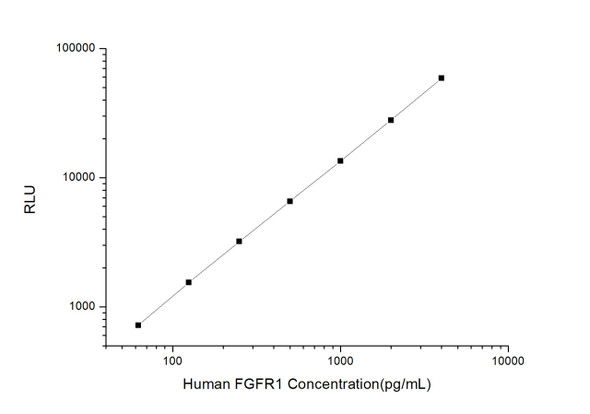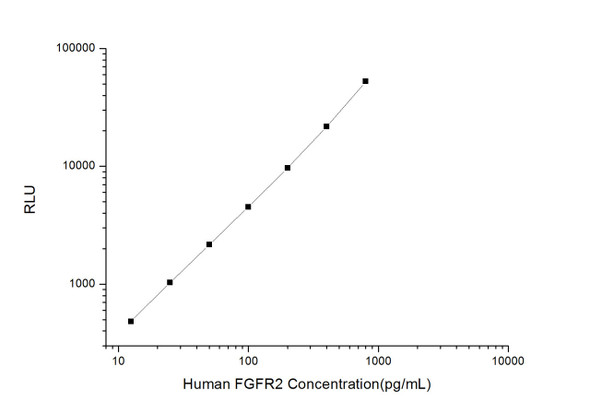Human Cell Biology ELISA Kits 3
Human FGFR4 (Fibroblast Growth Factor Receptor 4) CLIA Kit (HUES00254)
- SKU:
- HUES00254
- Product Type:
- ELISA Kit
- ELISA Type:
- CLIA Kit
- Size:
- 96 Assays
- Sensitivity:
- 18.75pg/mL
- Range:
- 31.25-2000pg/mL
- ELISA Type:
- Sandwich
- Synonyms:
- CD334, JTK2, TKF
- Reactivity:
- Human
- Sample Type:
- Serum, plasma and other biological fluids
- Research Area:
- Cell Biology
Description
| Assay type: | Sandwich |
| Format: | 96T |
| Assay time: | 4.5h |
| Reactivity: | Human |
| Detection method: | Chemiluminescence |
| Detection range: | 31.25-2000 pg/mL |
| Sensitivity: | 18.75 pg/mL |
| Sample volume: | 100µL |
| Sample type: | Serum, plasma and other biological fluids |
| Repeatability: | CV < 15% |
| Specificity: | This kit recognizes Human FGFR4 in samples. No significant cross-reactivity or interference between Human FGFR4 and analogues was observed. |
This kit uses Sandwich-CLIA as the method. The micro CLIA plate provided in this kit has been pre-coated with an antibody specific to Human FGFR4. Standards or samples are added to the appropriate micro CLIA plate wells and combined with the specific antibody. Then a biotinylated detection antibody specific for Human FGFR4 and Avidin-Horseradish Peroxidase (HRP) conjugate are added to each micro plate well successively and incubated. Free components are washed away. The substrate solution is added to each well. Only those wells that contain Human FGFR4, biotinylated detection antibody and Avidin-HRP conjugate will appear fluorescence. The Relative light unit (RLU) value is measured spectrophotometrically by the Chemiluminescence immunoassay analyzer. The RLU value is positively associated with the concentration of Human FGFR4. The concentration of Human FGFR4 in the samples can be calculated by comparing the RLU of the samples to the standard curve.
| UniProt Protein Function: | FGFR4: a tyrosine-kinase receptor that acts as cell-surface receptor for fibroblast growth factors and plays a role in the regulation of cell proliferation, differentiation and migration, and in regulation of lipid metabolism, bile acid biosynthesis, glucose uptake, vitamin D metabolism and phosphate homeostasis. Required for normal down-regulation of the expression of CYP7A1, the rate-limiting enzyme in bile acid synthesis, in response to FGF19. Phosphorylates PLCG1 and FRS2. Ligand binding leads to the activation of several signaling cascades. Activation of PLCG1 leads to the production of the cellular signaling molecules diacylglycerol and inositol 1,4,5-trisphosphate. Phosphorylation of FRS2 triggers recruitment of GRB2, GAB1, PIK3R1 and SOS1, and mediates activation of the MAP kinase and AKT signaling pathways. Promotes SRC-dependent phosphorylation of the matrix protease MMP14 and its lysosomal degradation. FGFR4 signaling is down-regulated by receptor internalization and degradation; MMP14 promotes internalization and degradation of FGFR4. Mutations that lead to constitutive kinase activation or impair normal FGFR4 inactivation lead to aberrant signaling. Two isoforms of the human protein are formed by alternative splicing. This description may include information from UniProtKB |
| UniProt Protein Details: | Protein type:Kinase, protein; EC 2. 7. 10. 1; Protein kinase, tyrosine (receptor); Protein kinase, TK; Membrane protein, integral; TK group; FGFR family Chromosomal Location of Human Ortholog: 5q35. 2 Cellular Component: cytoplasm; endoplasmic reticulum; endosome; extracellular region; Golgi apparatus; integral to plasma membrane; intercellular junction; nucleoplasm; plasma membrane; transport vesicle Molecular Function:ATP binding; fibroblast growth factor binding; fibroblast growth factor receptor activity; heparin binding; protein binding; protein-tyrosine kinase activity Biological Process: activation of MAPKK activity; axon guidance; cell migration; epidermal growth factor receptor signaling pathway; fibroblast growth factor receptor signaling pathway; glucose homeostasis; innate immune response; insulin receptor signaling pathway; MAPKKK cascade; nerve growth factor receptor signaling pathway; peptidyl-tyrosine phosphorylation; phosphate ion homeostasis; phosphoinositide-mediated signaling; positive regulation of cell proliferation; positive regulation of metalloenzyme activity; positive regulation of proteolysis; protein amino acid autophosphorylation; Ras protein signal transduction; regulation of lipid metabolic process; small GTPase mediated signal transduction; vascular endothelial growth factor receptor signaling pathway |
| NCBI Summary: | The protein encoded by this gene is a member of the fibroblast growth factor receptor family, where amino acid sequence is highly conserved between members and throughout evolution. FGFR family members differ from one another in their ligand affinities and tissue distribution. A full-length representative protein would consist of an extracellular region, composed of three immunoglobulin-like domains, a single hydrophobic membrane-spanning segment and a cytoplasmic tyrosine kinase domain. The extracellular portion of the protein interacts with fibroblast growth factors, setting in motion a cascade of downstream signals, ultimately influencing mitogenesis and differentiation. The genomic organization of this gene, compared to members 1-3, encompasses 18 exons rather than 19 or 20. Although alternative splicing has been observed, there is no evidence that the C-terminal half of the IgIII domain of this protein varies between three alternate forms, as indicated for members 1-3. This particular family member preferentially binds acidic fibroblast growth factor and, although its specific function is unknown, it is overexpressed in gynecological tumor samples, suggesting a role in breast and ovarian tumorigenesis. [provided by RefSeq, Jul 2008] |
| UniProt Code: | P22455 |
| NCBI GenInfo Identifier: | 13432140 |
| NCBI Gene ID: | 2264 |
| NCBI Accession: | P22455. 2 |
| UniProt Secondary Accession: | P22455,O43785, Q14309, Q71TW8, Q8TDA0, Q96KE5, G3JVM2 G3JVM5, G3JVM7, G3JVM9, |
| UniProt Related Accession: | P22455,AAB25788 |
| Molecular Weight: | 64,640 Da |
| NCBI Full Name: | Fibroblast growth factor receptor 4 |
| NCBI Synonym Full Names: | fibroblast growth factor receptor 4 |
| NCBI Official Symbol: | FGFR4 |
| NCBI Official Synonym Symbols: | TKF; JTK2; CD334 |
| NCBI Protein Information: | fibroblast growth factor receptor 4 |
| UniProt Protein Name: | Fibroblast growth factor receptor 4 |
| UniProt Synonym Protein Names: | CD_antigen: CD334 |
| Protein Family: | Fibroblast growth factor receptor |
| UniProt Gene Name: | FGFR4 |
| UniProt Entry Name: | FGFR4_HUMAN |
As the RLU values of the standard curve may vary according to the conditions of the actual assay performance (e. g. operator, pipetting technique, washing technique or temperature effects), the operator should establish a standard curve for each test. Typical standard curve and data is provided below for reference only.
| Concentration (pg/mL) | RLU | Average | Corrected |
| 2000 | 52415 59027 | 55721 | 55693 |
| 1000 | 22500 25448 | 23974 | 23946 |
| 500 | 11319 10745 | 11032 | 11004 |
| 250 | 5210 5378 | 5294 | 5266 |
| 125 | 2622 2594 | 2608 | 2580 |
| 62.5 | 1365 1257 | 1311 | 1283 |
| 31.25 | 666 682 | 674 | 646 |
| 0 | 28 28 | 28 | -- |
Precision
Intra-assay Precision (Precision within an assay): 3 samples with low, mid range and high level Human FGFR4 were tested 20 times on one plate, respectively.
Inter-assay Precision (Precision between assays): 3 samples with low, mid range and high level Human FGFR4 were tested on 3 different plates, 20 replicates in each plate.
| Intra-assay Precision | Inter-assay Precision | |||||
| Sample | 1 | 2 | 3 | 1 | 2 | 3 |
| n | 20 | 20 | 20 | 20 | 20 | 20 |
| Mean (pg/mL) | 96.50 | 310.09 | 682.92 | 104.11 | 299.51 | 627.13 |
| Standard deviation | 10.89 | 28.22 | 54.43 | 9.09 | 27.32 | 46.72 |
| C V (%) | 11.28 | 9.10 | 7.97 | 8.73 | 9.12 | 7.45 |
Recovery
The recovery of Human FGFR4 spiked at three different levels in samples throughout the range of the assay was evaluated in various matrices.
| Sample Type | Range (%) | Average Recovery (%) |
| Serum (n=5) | 90-106 | 97 |
| EDTA plasma (n=5) | 95-109 | 103 |
| Cell culture media (n=5) | 83-98 | 90 |
Linearity
Samples were spiked with high concentrations of Human FGFR4 and diluted with Reference Standard & Sample Diluent to produce samples with values within the range of the assay.
| Serum (n=5) | EDTA plasma (n=5) | Cell culture media (n=5) | ||
| 1:2 | Range (%) | 87-101 | 96-109 | 89-102 |
| Average (%) | 94 | 103 | 95 | |
| 1:4 | Range (%) | 96-107 | 95-110 | 94-107 |
| Average (%) | 102 | 102 | 100 | |
| 1:8 | Range (%) | 102-116 | 96-111 | 93-110 |
| Average (%) | 109 | 104 | 101 | |
| 1:16 | Range (%) | 91-104 | 85-98 | 99-113 |
| Average (%) | 96 | 92 | 105 |
An unopened kit can be stored at 4°C for 1 month. If the kit is not used within 1 month, store the items separately according to the following conditions once the kit is received.
| Item | Specifications | Storage |
| Micro CLIA Plate(Dismountable) | 8 wells ×12 strips | -20°C, 6 months |
| Reference Standard | 2 vials | |
| Concentrated Biotinylated Detection Ab (100×) | 1 vial, 120 µL | |
| Concentrated HRP Conjugate (100×) | 1 vial, 120 µL | -20°C(shading light), 6 months |
| Reference Standard & Sample Diluent | 1 vial, 20 mL | 4°C, 6 months |
| Biotinylated Detection Ab Diluent | 1 vial, 14 mL | |
| HRP Conjugate Diluent | 1 vial, 14 mL | |
| Concentrated Wash Buffer (25×) | 1 vial, 30 mL | |
| Substrate Reagent A | 1 vial, 5 mL | 4°C (shading light) |
| Substrate Reagent B | 1 vial, 5 mL | 4°C (shading light) |
| Plate Sealer | 5 pieces | |
| Product Description | 1 copy | |
| Certificate of Analysis | 1 copy |
- Set standard, test sample and control (zero) wells on the pre-coated plate and record theirpositions. It is recommended to measure each standard and sample in duplicate. Note: addall solutions to the bottom of the plate wells while avoiding contact with the well walls. Ensuresolutions do not foam when adding to the wells.
- Aliquot 100µl of standard solutions into the standard wells.
- Add 100µl of Sample / Standard dilution buffer into the control (zero) well.
- Add 100µl of properly diluted sample (serum, plasma, tissue homogenates and otherbiological fluids. ) into test sample wells.
- Cover the plate with the sealer provided in the kit and incubate for 90 min at 37°C.
- Aspirate the liquid from each well, do not wash. Immediately add 100µL of BiotinylatedDetection Ab working solution to each well. Cover the plate with a plate seal and gently mix. Incubate for 1 hour at 37°C.
- Aspirate or decant the solution from the plate and add 350µL of wash buffer to each welland incubate for 1-2 minutes at room temperature. Aspirate the solution from each well andclap the plate on absorbent filter paper to dry. Repeat this process 3 times. Note: a microplatewasher can be used in this step and other wash steps.
- Add 100µL of HRP Conjugate working solution to each well. Cover with a plate seal andincubate for 30 min at 37°C.
- Aspirate or decant the solution from each well. Repeat the wash process for five times asconducted in step 7.
- Add 100µL of Substrate mixture solution to each well. Cover with a new plate seal andincubate for no more than 5 min at 37°C. Protect the plate from light.
- Determine the RLU value of each well immediately.






